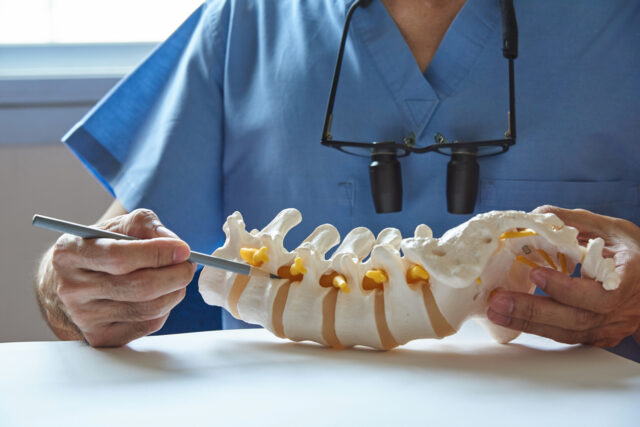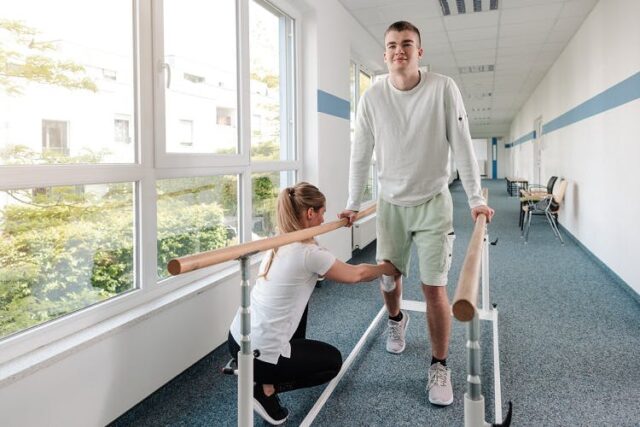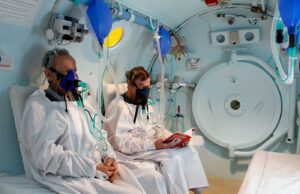
Spinal fusion is a surgical procedure to immobilize the vertebrae through the use of plates, bolts, etc. This type of surgery can be performed for intervertebral hernia, spinal canal stenosis, spondylolisthesis, and other diseases of the lumbar spine. Thanks to the surgery, it is possible to eliminate nerve root compression and thus relieve pain and numbness.
Possible complications of spondylosis

Damage to nerve endings and blood vessels, infection, and suppuration are possible during surgery. Breakage of the metal structure fixing the spine is possible. The bolts may become loose, which can lead to dislocation of the lumbar vertebrae.
In some cases there is an allergic reaction to the metal structures and artificial materials used during surgery.
In some cases, lumbar discomfort, weakness, pain, and other symptoms can persist for up to 1 year after surgery. Fixation of the spine may limit movements (bending, twisting, etc.).
Alternative to Spinal fusion

The clinic offers discectomy, a minimally invasive treatment alternative to Spinal fusion. This method is effective for intervertebral hernias, spinal canal stenosis, spondylolisthesis, degenerative spondylolisthesis, intervertebral disc degeneration, lumbar spine instability.
No incisions are made, so there is no damage to the ligaments. Using a special needle, a drug is injected into the intervertebral disc to help restore the disc. This prevents the nucleus of the disc from leaking out, and the inflammation that causes pain and numbness disappear.
The treatment is minimally invasive and does not require hospitalization. The patient is discharged from the clinic on the same day. Treatment is suitable for elderly patients and those for whom surgery has not helped. Treatment to prevent pain and numbness after spinal fixation is also possible.
The difference between Disk therapy and Spinal fusion
1. Treatment time

Spinal fusion is performed under general anesthesia. An incision is made with a scalpel, through which the arches, spinous processes of the vertebrae, and intervertebral joints are removed. The surgery time is about 2 hours. The procedure is performed in medical centers, for example, in Touch of Health.
Disk therapy is performed under local anesthesia. The procedure is performed using a special needle. No incisions are made and no scar remains. The time of the procedure is 25 minutes.
2. Possible complications
During Spinal fusion, an incision of about 15 mm is made, which can lead to postoperative complications and infection. In addition, the metal structure that fixes the spine can damage nerve endings, or develop an allergy to metal.
No incisions are made during the discectomy. The procedure is performed using a special needle with a diameter of about 0.8 mm. Damage to nerve endings, infection and the development of complications are minimized.
3. The possibility of relapse
It is believed that in 30-45% of cases after Spinal fusion there is a relapse. It is not uncommon to have repeated surgeries.
Disks therapy is aimed at restoring the intervertebral discs. The treatment prevents leakage of the gelatinous nucleus outside the discs, so the likelihood of recurrence is extremely low.
4. Recovery period

After Spinal fusion, a two-week hospitalization and rehabilitation period of 1 month is necessary.
Treatment in the clinic does not require hospitalization. In case of discectomy, the patient is discharged from the clinic 1-1.5 hours after completion of the procedure. The next day, you can return to your daily life, including sedentary work.
Performing a surgical fusion

The duration of surgery is usually a few hours, but in complicated cases the duration may be longer.
After making an incision in the area of the pathologic process (anterior or posterior access), the physician will pull the muscles apart, freeing up the area for surgery. After removal of the intervertebral disc, the bones of the adjacent vertebrae are joined directly, or:
1. Bone grafts are placed.
2. A special metal implant filled with bone material is placed between the vertebrae.
To fix the bones of the spine for the entire period of fusion, metal structures are used. Sutures or staples are applied to the surgical wound.
Possible risks and consequences of surgery

Fortunately, surgical Spinal fusion complications are extremely rare. But, like any other surgery, this surgical procedure can cause postoperative complications:
- Bleeding.
- Hematomas.
- Infection of the wound surface.
- Thrombosis.
- Allergic reaction to medications.
- Partial fusion or non- fusion of the bones of the spine.
- Damage to nerve roots, which, in turn, will lead to severe pain, paralysis, tingling, and numbness of parts of the body.
- Disruption of bowel and bladder functions.
Factors that significantly increase the risk of postoperative complications are the patient’s smoking, obesity and unbalanced diet, the presence of other diseases, and the patient’s age.








